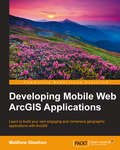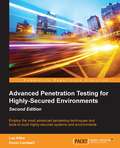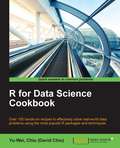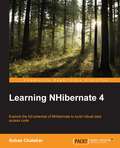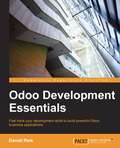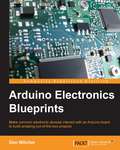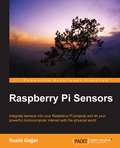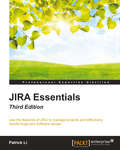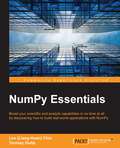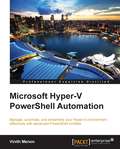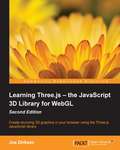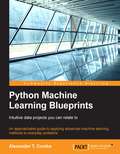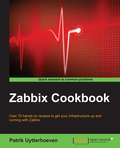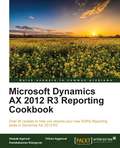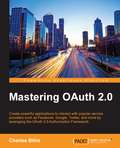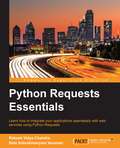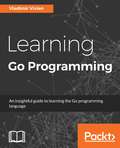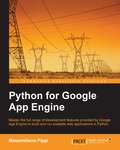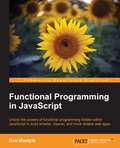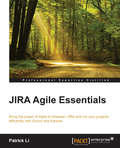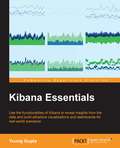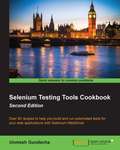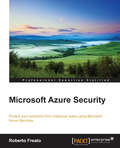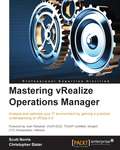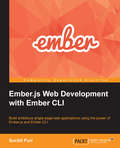- Table View
- List View
Developing Mobile Web ArcGIS Applications
by Matthew SheehanThis guide is invaluable to those just starting out with GIS development but will also benefit GIS professionals wishing to expand their development skills to include mobile apps.
Advanced Penetration Testing for Highly-Secured Environments - Second Edition
by Kevin Cardwell Lee AllenEmploy the most advanced pentesting techniques and tools to build highly-secured systems and environments About This Book * Learn how to build your own pentesting lab environment to practice advanced techniques * Customize your own scripts, and learn methods to exploit 32-bit and 64-bit programs * Explore a vast variety of stealth techniques to bypass a number of protections when penetration testing Who This Book Is For This book is for anyone who wants to improve their skills in penetration testing. As it follows a step-by-step approach, anyone from a novice to an experienced security tester can learn effective techniques to deal with highly secured environments. Whether you are brand new or a seasoned expert, this book will provide you with the skills you need to successfully create, customize, and plan an advanced penetration test. What You Will Learn * A step-by-step methodology to identify and penetrate secured environments * Get to know the process to test network services across enterprise architecture when defences are in place * Grasp different web application testing methods and how to identify web application protections that are deployed * Understand a variety of concepts to exploit software * Gain proven post-exploitation techniques to exfiltrate data from the target * Get to grips with various stealth techniques to remain undetected and defeat the latest defences * Be the first to find out the latest methods to bypass firewalls * Follow proven approaches to record and save the data from tests for analysis In Detail The defences continue to improve and become more and more common, but this book will provide you with a number or proven techniques to defeat the latest defences on the networks. The methods and techniques contained will provide you with a powerful arsenal of best practices to increase your penetration testing successes. The processes and methodology will provide you techniques that will enable you to be successful, and the step by step instructions of information gathering and intelligence will allow you to gather the required information on the targets you are testing. The exploitation and post-exploitation sections will supply you with the tools you would need to go as far as the scope of work will allow you. The challenges at the end of each chapter are designed to challenge you and provide real-world situations that will hone and perfect your penetration testing skills. You will start with a review of several well respected penetration testing methodologies, and following this you will learn a step-by-step methodology of professional security testing, including stealth, methods of evasion, and obfuscation to perform your tests and not be detected! The final challenge will allow you to create your own complex layered architecture with defences and protections in place, and provide the ultimate testing range for you to practice the methods shown throughout the book. The challenge is as close to an actual penetration test assignment as you can get! Style and approach The book follows the standard penetration testing stages from start to finish with step-by-step examples. The book thoroughly covers penetration test expectations, proper scoping and planning, as well as enumeration and foot printing
R for Data Science Cookbook
by Chiu Yu-WeiOver 100 hands-on recipes to effectively solve real-world data problems using the most popular R packages and techniques About This Book * Gain insight into how data scientists collect, process, analyze, and visualize data using some of the most popular R packages * Understand how to apply useful data analysis techniques in R for real-world applications * An easy-to-follow guide to make the life of data scientist easier with the problems faced while performing data analysis Who This Book Is For This book is for those who are already familiar with the basic operation of R, but want to learn how to efficiently and effectively analyze real-world data problems using practical R packages. What You Will Learn * Get to know the functional characteristics of R language * Extract, transform, and load data from heterogeneous sources * Understand how easily R can confront probability and statistics problems * Get simple R instructions to quickly organize and manipulate large datasets * Create professional data visualizations and interactive reports * Predict user purchase behavior by adopting a classification approach * Implement data mining techniques to discover items that are frequently purchased together * Group similar text documents by using various clustering methods In Detail This cookbook offers a range of data analysis samples in simple and straightforward R code, providing step-by-step resources and time-saving methods to help you solve data problems efficiently. The first section deals with how to create R functions to avoid the unnecessary duplication of code. You will learn how to prepare, process, and perform sophisticated ETL for heterogeneous data sources with R packages. An example of data manipulation is provided, illustrating how to use the "dplyr" and "data.table" packages to efficiently process larger data structures. We also focus on "ggplot2" and show you how to create advanced figures for data exploration. In addition, you will learn how to build an interactive report using the "ggvis" package. Later chapters offer insight into time series analysis on financial data, while there is detailed information on the hot topic of machine learning, including data classification, regression, clustering, association rule mining, and dimension reduction. By the end of this book, you will understand how to resolve issues and will be able to comfortably offer solutions to problems encountered while performing data analysis. Style and approach This easy-to-follow guide is full of hands-on examples of data analysis with R. Each topic is fully explained beginning with the core concept, followed by step-by-step practical examples, and concluding with detailed explanations of each concept used.
Learning NHibernate 4
by Suhas ChatekarThis book targets .NET developers who have never used an ORM before, developers who have used an ORM before but are new to NHibernate, or have used NHibernate sparingly and want to learn more about NHibernate.
Odoo Development Essentials
by Daniel ReisThis book is intended for developers who need to quickly become productive with Odoo. You are expected to have experience developing business applications, as well as an understanding of MVC application design and knowledge of the Python programming language.
Arduino Electronics Blueprints
by Don WilcherThis book is intended for those who want to learn about electronics and coding by building amazing devices and gadgets with Arduino. If you are an experienced developer who understands the basics of electronics, then you can quickly learn how to build smart devices using Arduino. The only experience needed is a desire to learn about electronics, circuit breadboarding, and coding.
Raspberry Pi Sensors
by Rushi GajjarThis book is perfect for hardware enthusiasts who want to develop amazing projects using Raspberry Pi. Some knowledge and experience working with Linux, C, and Python is a plus, but once you're set up to go, you'll be ready to push the creative capabilities of your Raspberry Pi even further.
JIRA Essentials - Third Edition
by Patrick LiIf you wish to develop your practical skills with JIRA in order to install, use, and manage your projects, then this is the perfect book for you. You need to be familiar with software project management and basic computer operations, specifically the system on which you will use JIRA.
NumPy Essentials
by Tanmay Dutta Leo Liang-Huan ChinBoost your scientific and analytic capabilities in no time at all by discovering how to build real-world applications with NumPy About This Book * Optimize your Python scripts with powerful NumPy modules * Explore the vast opportunities to build outstanding scientific/ analytical modules by yourself * Packed with rich examples to help you master NumPy arrays and universal functions Who This Book Is For If you are an experienced Python developer who intends to drive your numerical and scientific applications with NumPy, this book is for you. Prior experience or knowledge of working with the Python language is required. What You Will Learn * Manipulate the key attributes and universal functions of NumPy * Utilize matrix and mathematical computation using linear algebra modules * Implement regression and curve fitting for models * Perform time frequency / spectral density analysis using the Fourier Transform modules * Collate with the distutils and setuptools modules used by other Python libraries * Establish Cython with NumPy arrays * Write extension modules for NumPy code using the C API * Build sophisticated data structures using NumPy array with libraries such as Panda and Scikits In Detail In today's world of science and technology, it's all about speed and flexibility. When it comes to scientific computing, NumPy tops the list. NumPy gives you both the speed and high productivity you need. This book will walk you through NumPy using clear, step-by-step examples and just the right amount of theory. We will guide you through wider applications of NumPy in scientific computing and will then focus on the fundamentals of NumPy, including array objects, functions, and matrices, each of them explained with practical examples. You will then learn about different NumPy modules while performing mathematical operations such as calculating the Fourier Transform; solving linear systems of equations, interpolation, extrapolation, regression, and curve fitting; and evaluating integrals and derivatives. We will also introduce you to using Cython with NumPy arrays and writing extension modules for NumPy code using the C API. This book will give you exposure to the vast NumPy library and help you build efficient, high-speed programs using a wide range of mathematical features. Style and approach This quick guide will help you get to grips with the nitty-gritties of NumPy using with practical programming examples. Each topic is explained in both theoretical and practical ways with hands-on examples providing you efficient way of learning and adequate knowledge to support your professional work.
Microsoft Hyper-V PowerShell Automation
by Vinith MenonThis book is great for administrators who are new to automating Hyper-V administration tasks using PowerShell. If you are familiar with the PowerShell command line and have some experience with the Windows Server, this book is perfect for you.
Learning Three.js – the JavaScript 3D Library for WebGL Second Edition
by Jos Dirksen<P><P>Create stunning 3D graphics in your browser using the Three.js JavaScript library <P><P>About This Book <P><P>Enhance your 3D graphics with light sources, shadows, advanced materials, and textures <P><P>Load models from external sources, and visualize and animate them directly from JavaScript <P><P>Each subject is explained using extensive examples that you can use directly and adapt for your own purposes <P><P>Who This Book Is For <P><P>If you know JavaScript and want to start creating 3D graphics that run in any browser, this book is a great choice for you. You don't need to know anything about math or WebGL; all that you need is general knowledge of JavaScript and HTML. <P><P>What You Will Learn <P><P>Use the different geometries that are provided by Three.js <P><P>Apply realistic lighting and shadows to the 3D objects you have created <P><P>Use the different camera controls provided by Three.js to effortlessly navigate around your 3D scene <P><P>Make use of advanced textures on materials to create realistic-looking 3D objects by using bump maps, normal maps, specular maps, and light maps <P><P>Import and animate models from external formats, such as OBJ, STL, Collada, and many more <P><P>Create and run animations using morph targets and bone animations <P><P>Explore the Physijs JavaScript library to apply physics to your 3D objects <P><P>Interact directly with WebGL by creating custom vertex and fragment shaders
Python Machine Learning Blueprints: Intuitive data projects you can relate to
by Alexander T. CombsAn approachable guide to applying advanced machine learning methods to everyday problems About This Book * Put machine learning principles into practice to solve real-world problems * Get to grips with Python's impressive range of Machine Learning libraries and frameworks * From retrieving data from APIs to cleaning and visualization, become more confident at tackling every stage of the data pipeline Who This Book Is For Python programmers and data scientists - put your skills to the test with this practical guide dedicated to real-world machine learning that makes a real impact. What You Will Learn * Explore and use Python's impressive machine learning ecosystem * Successfully evaluate and apply the most effective models to problems * Learn the fundamentals of NLP - and put them into practice * Visualize data for maximum impact and clarity * Deploy machine learning models using third party APIs * Get to grips with feature engineering In Detail Machine Learning is transforming the way we understand and interact with the world around us. But how much do you really understand it? How confident are you interacting with the tools and models that drive it? Python Machine Learning Blueprints puts your skills and knowledge to the test, guiding you through the development of some awesome machine learning applications and algorithms with real-world examples that demonstrate how to put concepts into practice. You'll learn how to use cluster techniques to discover bargain air fares, and apply linear regression to find yourself a cheap apartment - and much more. Everything you learn is backed by a real-world example, whether its data manipulation or statistical modelling. That way you're never left floundering in theory - you'll be simply collecting and analyzing data in a way that makes a real impact. Style and approach Packed with real-world projects, this book takes you beyond the theory to demonstrate how to apply machine learning techniques to real problems.
Zabbix Cookbook
by Patrik UytterhoevenIf you have some experience with Zabbix and wish to take your infrastructure to the next level, then this book is for you. Before you start with Zabbix, or monitoring in general, it is best to have some basic Linux knowledge and a good understanding of snmp, virtualization, and scripting.
Microsoft Dynamics AX 2012 R3 Reporting Cookbook
by Deepak Agarwal Chhavi AggarwalMicrosoft Dynamics AX 2012 R3 Reporting Cookbook is recommended for Dynamics AX developers and .NET-based SSRS developers looking to familiarize themselves with the new AX reporting framework.
Mastering OAuth 2.0
by Charles BihisCreate powerful applications to interact with popular service providers such as Facebook, Google, Twitter, and more by leveraging the OAuth 2.0 Authorization FrameworkAbout This BookLearn how to use the OAuth 2.0 protocol to interact with the world's most popular service providers, such as Facebook, Google, Instagram, Slack, Box, and moreMaster the finer details of this complex protocol to maximize the potential of your application while maintaining the utmost of securityStep through the construction of a real-world working application that logs you in with your Facebook account to create a compelling infographic about the most important person in the world--you!Who This Book Is ForIf you are an application developer, software architect, security engineer, or even a casual programmer looking to leverage the power of OAuth, Mastering OAuth 2.0 is for you. Covering basic topics such as registering your application and choosing an appropriate workflow, to advanced topics such as security considerations and extensions to the specification, this book has something for everyone. A basic knowledge of programming and OAuth is recommended.What You Will LearnDiscover the power and prevalence of OAuth 2.0 and use it to improve your application's capabilitiesStep through the process of creating a real-world application that interacts with Facebook using OAuth 2.0Examine the various workflows described by the specification, looking at what they are and when to use themLearn about the many security considerations involved with creating an application that interacts with other service providersDevelop your debugging skills with dedicated pages for tooling and troubleshootingBuild your own rich, powerful applications by leveraging world-class technologies from companies around the worldIn DetailOAuth 2.0 is a powerful authentication and authorization framework that has been adopted as a standard in the technical community. Proper use of this protocol will enable your application to interact with the world's most popular service providers, allowing you to leverage their world-class technologies in your own application. Want to log your user in to your application with their Facebook account? Want to display an interactive Google Map in your application? How about posting an update to your user's LinkedIn feed? This is all achievable through the power of OAuth.With a focus on practicality and security, this book takes a detailed and hands-on approach to explaining the protocol, highlighting important pieces of information along the way.At the beginning, you will learn what OAuth is, how it works at a high level, and the steps involved in creating an application. After obtaining an overview of OAuth, you will move on to the second part of the book where you will learn the need for and importance of registering your application and types of supported workflows. You will discover more about the access token, how you can use it with your application, and how to refresh it after expiration.By the end of the book, you will know how to make your application architecture robust. You will explore the security considerations and effective methods to debug your applications using appropriate tools. You will also have a look at special considerations to integrate with OAuth service providers via native mobile applications. In addition, you will also come across support resources for OAuth and credentials grant.Style and approachWith a focus on practicality and security, Mastering OAuth 2.0 takes a top-down approach at exploring the protocol. Discussed first at a high level, examining the importance and overall structure of the protocol, the book then dives into each subject, adding more depth as we proceed. This all culminates in an example application that will be built, step by step, using the valuable and practical knowledge you have gained.
Python Requests Essentials
by Rakesh Vidya Chandra Bala Subrahmanyam VaranasiIf you are a Python administrator or developer interested in interacting with web APIs and have a passion for creating your own web applications, this is the book for you. Basic knowledge of Python programming, APIs, and web services will be an advantage.
Learning Go Programming
by Vladimir VivienAn insightful guide to learning the Go programming language About This Book * Insightful coverage of Go programming syntax, constructs, and idioms to help you understand Go code effectively * Push your Go skills, with topics such as, data types, channels, concurrency, object-oriented Go, testing, and network programming * Each chapter provides working code samples that are designed to help reader quickly understand respective topic Who This Book Is For If you have prior exposure to programming and are interested in learning the Go programming language, this book is designed for you. It will quickly run you through the basics of programming to let you exploit a number of features offered by Go programming language. What You Will Learn * Install and configure the Go development environment to quickly get started with your first program. * Use the basic elements of the language including source code structure, variables, constants, and control flow primitives to quickly get started with Go * Gain practical insight into the use of Go's type system including basic and composite types such as maps, slices, and structs. * Use interface types and techniques such as embedding to create idiomatic object-oriented programs in Go. * Develop effective functions that are encapsulated in well-organized package structures with support for error handling and panic recovery. * Implement goroutine, channels, and other concurrency primitives to write highly-concurrent and safe Go code * Write tested and benchmarked code using Go's built test tools * Access OS resources by calling C libraries and interact with program environment at runtime In Detail The Go programming language has firmly established itself as a favorite for building complex and scalable system applications. Go offers a direct and practical approach to programming that let programmers write correct and predictable code using concurrency idioms and a full-featured standard library. This is a step-by-step, practical guide full of real world examples to help you get started with Go in no time at all. We start off by understanding the fundamentals of Go, followed by a detailed description of the Go data types, program structures and Maps. After this, you learn how to use Go concurrency idioms to avoid pitfalls and create programs that are exact in expected behavior. Next, you will be familiarized with the tools and libraries that are available in Go for writing and exercising tests, benchmarking, and code coverage. Finally, you will be able to utilize some of the most important features of GO such as, Network Programming and OS integration to build efficient applications. All the concepts are explained in a crisp and concise manner and by the end of this book; you would be able to create highly efficient programs that you can deploy over cloud. Style and approach The book is written to serve as a reader-friendly step-by-step guide to learning the Go programming language. Each topic is sequentially introduced to build on previous materials covered. Every concept is introduced with easy-to-follow code examples that focus on maximizing the understanding of the topic at hand.
Python for Google App Engine
by Massimiliano PippiIf you are a Python developer, whether you have experience in web applications development or not, and want to rapidly deploy a scalable backend service or a modern web application on Google App Engine, then this book is for you.
Functional Programming in JavaScript
by Dan MantylaIf you are a JavaScript developer interested in learning functional programming, looking for the quantum leap towards mastering the JavaScript language, or just want to become a better programmer in general, then this book is ideal for you. It is aimed at programmers involved in developing reactive frontend apps, server-side apps that wrangle with reliability and concurrency, and everything in between.
JIRA Agile Essentials
by Patrick LiIf you want to get started with JIRA Agile and learn how to run your JIRA projects the agile way, then this is the perfect book for you. You will need to be familiar with the basics of JIRA, both from an end user's and an administrator's perspective. Experience with workflows, custom fields, and other administrative functions of JIRA will be useful.
Kibana Essentials
by Yuvraj GuptaUse the functionalities of Kibana to discover data and build attractive visualizations and dashboards for real-world scenariosAbout This BookPerform real-time data analytics and visualizations, on streaming data, using KibanaBuild beautiful visualizations and dashboards with simplicity and ease without any type of coding involvedLearn all the core concepts as well as detailed information about each component used in KibanaWho This Book Is ForWhether you are new to the world of data analytics and data visualization or an expert, this book will provide you with the skills required to use Kibana with ease and simplicity for real-time data visualization of streaming data.This book is intended for those professionals who are interested in learning about Kibana,its installations, and how to use it . As Kibana provides a user-friendly web page, no prior experience is required.What You Will LearnUnderstand the basic concepts of elasticsearch used in Kibana along with step by step guide to install Kibana in Windows and UbuntuExplore the functionality of all the components used in Kibana in detail, such as the Discover, Visualize, Dashboard,and Settings pagesAnalyze data using the powerful search capabilities of elasticsearchUnderstand the different types of aggregations used in Kibana for visualizationCreate and build different types of amazing visualizations and dashboards easilyCreate, save, share, embed, and customize the visualizations added to the dashboardCustomize and tweak the advanced settings of Kibana to ensure ease of useIn DetailWith the increasing interest in data analytics and visualization of large data around the globe, Kibana offers the best features to analyze data and create attractive visualizations and dashboards through simple-to-use web pages. The variety of visualizations provided, combined with the powerful underlying elasticsearch capabilities will help professionals improve their skills with this technology.This book will help you quickly familiarize yourself to Kibana and will also help you to understand the core concepts of this technology to build visualizations easily.Starting with setting up of Kibana and elasticsearch in Windows and Ubuntu, you will then use the Discover page to analyse your data intelligently. Next, you will learn to use the Visualization page to create beautiful visualizations without the need for any coding. Then, you will learn how to use the Dashboard page to create a dashboard and instantly share and embed the dashboards. You will see how to tweak the basic and advanced settings provided in Kibana to manage searches, visualizations, and dashboards. Finally, you will use Kibana to build visualizations and dashboards for real-world scenarios.You will quickly master the functionalities and components used in Kibana to create amazing visualizations based on real-world scenarios. With ample screenshots to guide you through every step, this book will assist you in creating beautiful visualizations with ease.Style and approachThis book is a comprehensive step-by-step guide to help you understand Kibana. It's explained in an easy-to-follow style along with supporting images. Every chapter is explained sequentially , covering the basics of each component of Kibana and providing detailed explanations of all the functionalities of Kibana that appeal.
Selenium Testing Tools Cookbook Second Edition
by Unmesh GundechaThis is a cookbook packed with code examples and step-by-step instructions to ease your learning curve. This book is intended for software quality assurance/testing professionals, software project managers, or software developers with prior experience in using Selenium and Java for testing web-based applications. This book also provides examples for C#, Python, and Ruby users.
Microsoft Azure Security
by Roberto FreatoThis book is intended for Azure administrators who want to understand the application of security principles in distributed environments and how to use Azure to its full capability to reduce the risks of security breaches. Only basic knowledge of the security processes and services of Microsoft Azure is required.
Mastering vRealize Operations Manager
by Scott Norris Christopher Slater<P><P>Analyze and optimize your IT environment by gaining a practical understanding of vROps 6.0 <P><P>About This Book <P><P>Get complete control of capacity management in your virtual environment <P><P>Display the most appropriate performance metrics and assemble your own dashboard <P><P>Analyze and process data from different sources into a single repository, allowing you to understand every layer of your environment <P><P>Who This Book Is For <P><P>If you are an administrator of a virtual environment and have used vROps before but want to gain a professional understanding by implementing complex tasks easily with it, then this book is for you. <P><P>What You Will Learn <P><P>Discover advanced vROps concepts and design your processes effectively for the underlying architecture <P><P>Migrate from previous versions or install new versions <P><P>Apply proven capacity management theories and techniques in practical, real-world environments <P><P>Manipulate data and metrics to display them in the most effective way possible <P><P>Create custom dashboards fit for any use case <P><P>Make better use of the powerful analytics engine by bringing in external data with third-party adapters and the REST API <P><P>Explore how policies have evolved in vROps 6.0 and how to apply them in the most effective manner <P><P>In Detail <P><P>As x86 server virtualization becomes mainstream for even the most demanding applications, the criticality of managing the heath and efficiency of virtualized environments is more important than ever. vRealize Operations Manager 6.0 (vROps 6.0) is the key to simplify operations of your virtualized environment and move from being reactive to proactive. <P><P>Mastering vRealize Operations Manager 6.0 helps you streamline your processes and customize the environment to suit your needs. You will gain visibility across all devices in the network and retain full control. With easy-to-follow, step-by-step instructions and support images, you will quickly master the ability to manipulate your data and display it in a way that best suits you and the requirements of your colleagues. From the new and impressive vROps 6.0 platform architecture to troubleshooting and capacity planning, this book is aimed at ensuring you get the knowledge to manage your virtualized environment as effectively as possible.
Ember.js Web Development with Ember CLI
by Suchit PuriIf you are a JavaScript developer who is starting out to build ambitious Ember.js application, or a developer who has prior Ember.js experience and want to transition your application to the latest Ember.js version with Ember CLI, then this book is for you.
